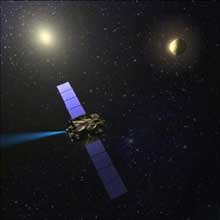This area deals with the fundamental laws and building blocks of nature and how they interact, the properties and the behavior of matter, and research into space and time and their structures.
innovations-report provides in-depth reports and articles on subjects such as astrophysics, laser technologies, nuclear, quantum, particle and solid-state physics, nanotechnologies, planetary research and findings (Mars, Venus) and developments related to the Hubble Telescope.

Researchers at the University of Michigan’s Center for Optical Coherent and Ultrafast Science (FOCUS) and Department of Physics have reported the first demonstration of laser-cooling of individual trapped atoms of different species. This may be an important step in the construction of a future “quantum computer,” in which quantum superpositions of inputs are processed simultaneously in a single device. Trapped atoms offer one of the only realistic approaches to precisely controlling the complex

Three small, faint stars, apparently locked in the gravitational embrace of much larger and brighter companions, have been discovered in the first light from a new infrared camera with innovative optics on the 100-inch telescope at the Mount Wilson Observatory in Pasadena, California.
“This is the first time the historic Mount Wilson telescope has looked at the universe through this new infrared eye, and already it is making new discoveries,” says Jian Ge, assistant professor of astronomy an

As scientists demand more from space missions travelling to other worlds and beyond, traditional rocket technologies are beginning to show shortcomings. In response, ESA are helping to develop a new type of rocket engine, known as solar-electric propulsion, or more commonly, an ion engine, that can mark a whole new era of space exploration.
Solar-electric propulsion is ESA`s new spacecraft engine. It does not burn fuel as chemical rockets do; instead the technique converts sunlight into elec

Like ’flower power’ tattoos on aging ex-hippy baby boomers, unexpectedly large numbers of neutron stars and black holes in elliptical galaxies suggest some of these galaxies lived through a much wilder youth. The discovery by NASA’s Chandra X-ray Observatory may require a revision of how elliptical galaxies evolved.
“For the first time, Chandra has allowed us to distinguish hundreds of star-like sources that are black holes and neutron stars in distant elliptical galaxies,” said Craig Sara

The Star Tiger team today begins a four-month pioneering research and development project at Rutherford Appleton Laboratories (RAL), which could lead to a real breakthrough for submillimetre wave imaging.
For the first time under the ESA Star Tiger initiative, eleven scientists and specialists from seven different European countries (The United Kingdom, Ireland, Italy, Germany, France, the Netherlands, and Spain) are working together in an innovative way. The idea is to get together a small

Researchers at the U.S. Department of Energy’s Los Alamos National Laboratory believe that magnetic field lines extending a few million light years from galaxies into space may be the result of incredibly efficient energy-producing dynamos within black holes that are somewhat analogous to an electric motor. Los Alamos researchers Philipp Kronberg, Quentin Dufton, Stirling Colgate and Hui Li today discussed this finding at the American Astronomical Society meeting in Albuquerque, N.M.
B